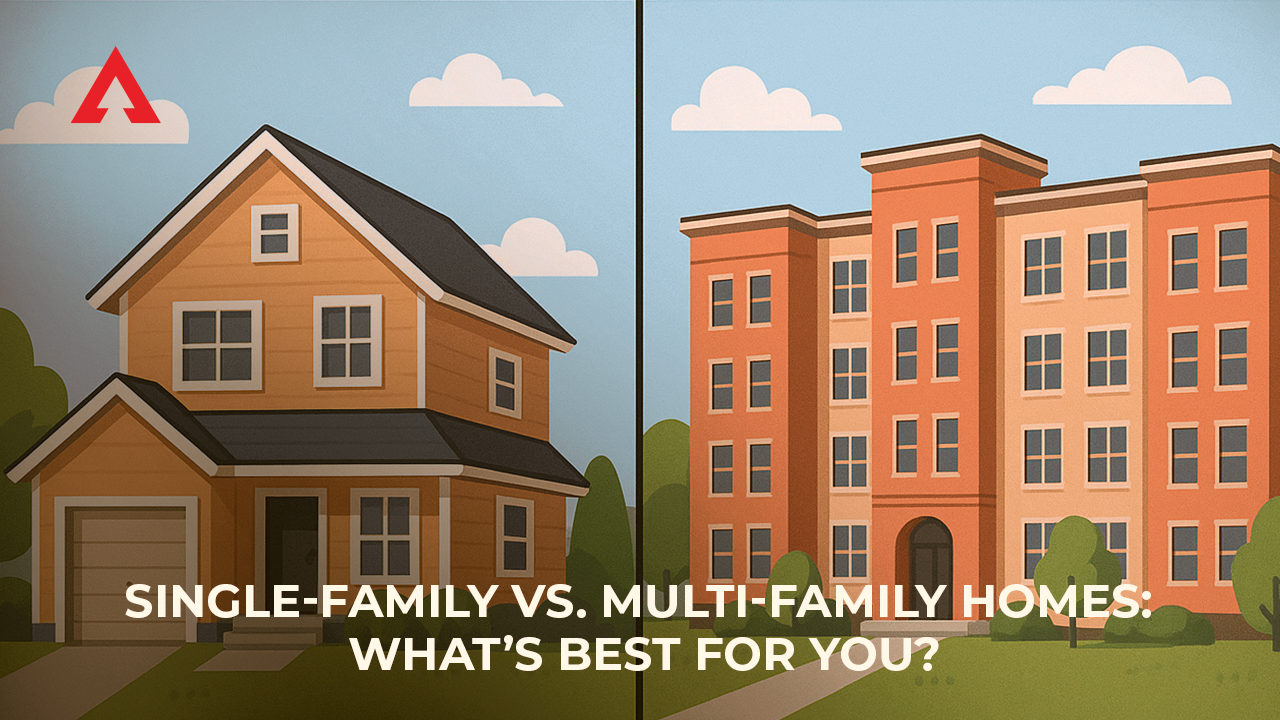Mon, Jul 7, 2025
Read in 7 minutes
When it comes to buying a home, either to live in or invest in, one of the biggest decisions you'll make is whether to choose a single-family home or a multi-family home. Each comes with its own advantages, trade-offs, and long-term implications.

When it comes to buying a home, either to live in or invest in, one of the biggest decisions you’ll make is whether to choose a single-family home or a multi-family home. Each comes with its own advantages, trade-offs, and long-term implications.
This guide will break down the key differences between the two, explore the benefits of single-family homes, highlight multi-family investment advantages, and help you determine what aligns best with your financial goals, lifestyle, or investment strategy.
A single-family home is a standalone residential structure that houses one family. It typically includes a private yard, garage, and is not attached to any other units. This property type is often located in suburban neighborhoods and is favored by families seeking space, privacy, and independence.
Single-family homes are popular for first-time buyers and long-term homeowners who prioritize autonomy and space.
A multi-family home is a residential property that contains two or more separate housing units. These units can be in the form of duplexes, triplexes, fourplexes, or even small apartment complexes. Each unit is self-contained and can be rented or occupied individually.
Multi-family homes are a go-to for real estate investors looking for cash flow from multi-family homes, or for families who want to live in one unit while renting the others.
One of the main benefits of single-family homes is affordability for first-time buyers. These homes typically come with a lower purchase price than multi-family properties, especially in suburban or semi-urban areas.
You may also qualify for various types of financing, including:
These loans often offer lower down payments, making single-family homes more accessible to new buyers.
Multi-family homes for sale often come with a higher upfront cost, depending on the number of units. A duplex will cost more than a single-family home, and a fourplex even more. However, the higher cost can be offset by rental income from additional units.
Financing is also different:
This means stricter requirements, larger down payments (20–30%), and sometimes higher interest rates.
If you’re purchasing a single-family home as an investment property, the income potential is limited to a single stream, one tenant or household paying rent.
Pros:
Cons:
This makes it a relatively riskier investment in terms of cash flow, especially in slow rental markets.
This is where multi-family investment advantages shine. With multiple units, you get:
You can also house hack—live in one unit and rent out the others, helping to offset your mortgage and living costs.
This makes multi-family homes especially appealing for investors looking to build long-term, scalable income.
Maintenance for a single-family home is typically simpler. You only have:
In most rental cases, tenants take on lawn care and minor interior maintenance. You can either manage it yourself or hire a part-time property manager.
This low-maintenance setup is attractive for those looking for a more passive real estate investment.
Owning a multi-family property increases the complexity:
You may need to hire a property management company to deal with:
While this adds cost, many investors build it into their operating budget, especially when cash flow is healthy.
Single-family homes typically see better appreciation rates over time. They appeal to a larger buyer pool (families, retirees, investors), and their value is often driven by:
This makes them easier to sell and often at higher margins. Because they’re emotionally appealing (not just income-based), buyers are sometimes willing to pay more.
Multi-family properties are valued differently. Their value is largely driven by:
This means if you’re not actively increasing rents or maintaining a low vacancy rate, your property’s market value may stagnate. Plus, your resale market is mostly limited to other investors, a much smaller buyer pool.
If you’re buying a home to live in, a single-family home offers unmatched privacy and control:
It’s ideal for families, retirees, or anyone who values space, tranquility, and independence.
Living in a multi-family unit comes with trade-offs:
However, if you own and live in one unit while renting others, it offers the rare opportunity to offset your cost of living. This hybrid model is becoming increasingly popular in urban settings.
When it comes to risk, both options have their pros and cons.
Risks:
Advantages:
Risks:
Advantages:
Multi-family homes tend to be more environmentally efficient:
In contrast, single-family homes often require:
For eco-conscious buyers, this could influence their decision, especially in urban markets focused on sustainability.
When comparing single-family homes vs multi-family, your decision depends on your purpose—living vs investing, stability vs scalability, and simplicity vs cash flow.
There’s no one-size-fits-all solution. Some buyers will thrive in a cozy, autonomous single-family residence. Others will find wealth-building opportunities in multi-unit investments. The right decision depends on your financial position, lifestyle goals, and risk tolerance.
Whatever you choose, remember to consider all aspects: financing, income, management, resale, and future flexibility. Whether you’re planning to buy your first home or grow your investment portfolio, understanding the benefits of single-family home ownership versus the advantages of multi-family investment can lead you to a more secure, rewarding real estate journey.